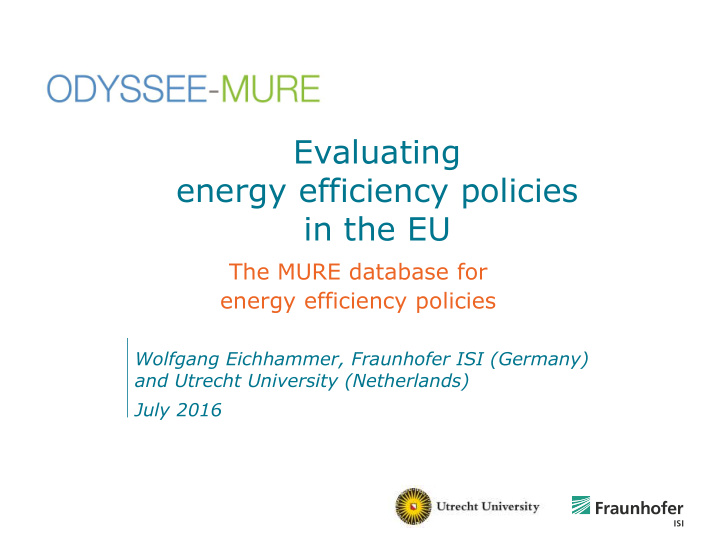



Evaluating energy efficiency policies in the EU The MURE database for energy efficiency policies Wolfgang Eichhammer, Fraunhofer ISI (Germany) and Utrecht University (Netherlands) July 2016
About Fraunhofer : Europe’s largest Organisation for Applied Research 67 Fraunhofer Institutes in Germany 24 000 employees (mainly natural or engineering science training) € 2.2 billion research volume annually: 70% of income generated from contracts 30% provided by the federal government and federal states as basic funding International cooperation via affiliated offices in Europe, USA, Asia and in the Near East Energy efficiency policies in EU – July 2016 2
The following analysis is based on the The 2015 synthesis 2015 ODYSSEE MURE synthesis brochure with brochure energy efficiency up to 2014 The MURE data tools http://www.measures-odyssee-mure.eu/ http://www.odyssee- mure.eu/publications/br/energy- efficiency-trends-policies-in-europe.html Energy efficiency polices in EU – July 2016 3
Content • EU Energy Efficiency Policies • Identify Successful Policies • Policy Mapper/Policy Interaction • Energy Efficiency Policy Scoreboard Energy efficiency polices in EU – July 2016 4
EU Energy Efficiency Policies Energy efficiency policies in EU – July 2016
Analyzing Energy Efficiency Measures in MURE Energy efficiency policies – MURE – July 2016 6
Preferential energy efficiency measures households (left all measures from 1995, right NEEAP3 /Art.7 measures) Energy efficiency policies – MURE – July 2016 7
Country-specific preferential energy efficiency measures households Energy efficiency policies – MURE – July 2016 8
Main EU energy efficiency policy measures and their impacts Energy efficiency policies – MURE – July 2016 9
Successful Policy Measures Energy efficiency policies in EU – July 2016
Criteria for Successful Measures (High Priority Criteria) 1. High impact / high number of applicants 2. Cost efficiency for the implementor / necessary administrative support 3. Potential for market transformation and for promotion of energy service market 4. Suitability to overcome barriers for energy efficiency 5. Ease and stability of re-financing 6. Persistency of the savings induced by the measure Energy efficiency policies – MURE – July 2016 11
Criteria for Successful Measures (Low Priority Criteria) 7. Transferability between countries 8. Link to other measures / policy packages 9. Some experience with measure 10.Avoidance of negative side-effects 11.Support of positive side-effects 12.Ease of acceptance by relevant stakeholders Quantitative evaluation of each policy with a score between 1 (worst) and 5 (best) for each of the 12 criteria Energy efficiency policies – MURE – July 2016 12
Learning to evaluate through National Energy Efficiency Action Plans NEEAPs Share of measures with quantitative impact evaluations (by sector) Energy efficiency policies – MURE – July 2016 13
Policy Mapper / Policy Interaction Energy efficiency policies in EU – July 2016
Policy Mapping (Example Space Heating Existing Dwellings Finland) Energy efficiency policies – MURE – July 2016 15
Link Policies/Indicators (Example Space Heating Existing Dwellings Finland) Energy efficiency policies – MURE – July 2016 16
Measure Interactions (Example Space Heating Existing Dwellings Finland) Energy efficiency policies – MURE – July 2016 17
Measure Interaction Matrix Energy efficiency policies – MURE – July 2016 18
Most successful energy efficiency measures Germany Energy efficiency policies – MURE – July 2016 19
Policy Scoreboard Energy efficiency policies in EU – July 2016
Four main scoring approaches • Output-based scoring (based on energy savings) • Output-based scoring (related to energy efficiency potentials) • Output-based scoring ( related to 2020 energy efficiency targets) • Input-based scoring (based on financing volumes) Energy efficiency policies – MURE – July 2016 21
Input-based Scoreboard: ACEEE Energy efficiency policies – MURE – July 2016 22
Basic methodology for the Output- based Scoreboard Energy efficiency policies – MURE – July 2016 23
Combined Energy Efficiency Scoreboard presented in Germany Status: left, trend: middle, energy efficiency policies: right Energy efficiency policies – MURE – July 2016 24
Contact: Wolfgang Eichhammer Fraunhofer Institute for Systems and Innovation Research ISI and Thank you for your Utrecht University attention ! Technical Coordinator Odyssee-MURE wolfgang.eichhammer@isi. fraunhofer.de www.isi.fraunhofer.de Energy efficiency policies – MURE – July 2016 25
Recommend
More recommend